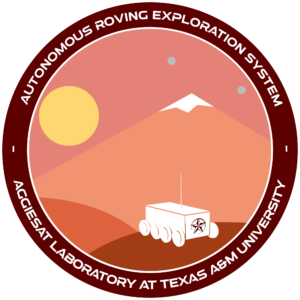Status: Concluded
Mission Statement
The Autonomous Roving Exploration System (ARES) rover aims to autonomously locate and navigate to a radio beacon in an environment simulating an unknown planetary surface, where the system will collect environmental data and transmit it back to a ground station.
Project Overview
ARES is an entry-level rover project organized by the AggieSat Laboratory that serves to teach and enforce the foundational systems engineering skills upheld by the lab. Simulating planetary surface operations, the mission demonstrates key technologies necessary for robotic navigation and situational awareness in unknown environments. Unlike traditional systems that rely on pre-mapped terrain data, ARES autonomously locates and navigates toward an active radio beacon within an uncharted, simulated extraterrestrial environment.
Using a combination of onboard sensors and an internally developed beacon-finding algorithm, ARES processes real-time environmental and signal data to determine the beacon’s relative direction and distance. The rover’s autonomous system then reorients itself towards the beacon and executes a straight path, using its array of ultrasonic sensors and magnetometer to avoid obstacles and maintain heading toward its target. Upon arrival, ARES collects environmental data — primarily temperature and wind speed — and uses a separate radio system to transmit the information back to a ground station for analysis.
To execute this mission, ARES is organized across five subteams addressing separate disciplines: structures (TMS), electronics (EPS), embedded software development (CDH), autonomous navigation and control (GNC), and RF communications (COM). ARES also emphasizes the upkeep of systems engineering documentation to simulate the industry standard for project development. By balancing foundational engineering principles with advanced technical learning, ARES serves as a launchpad for members to contribute to and lead future projects in the lab and beyond.
Project Conclusion
With a total project timeline of under 8 months, ARES concluded at the end of April 2025. ARES was deployed in a custom environment with strategically placed obstacles to test the rover’s performance in various situations, and a successful mission was judged on adherence to structural limitations, final proximity to the radio beacon, and the validation of environmental data.
Project PAR
The Performance Analysis Review (PAR) allows students to review how the project was designed, executed, and what the team learned from the project. The ARES PAR is linked below.

